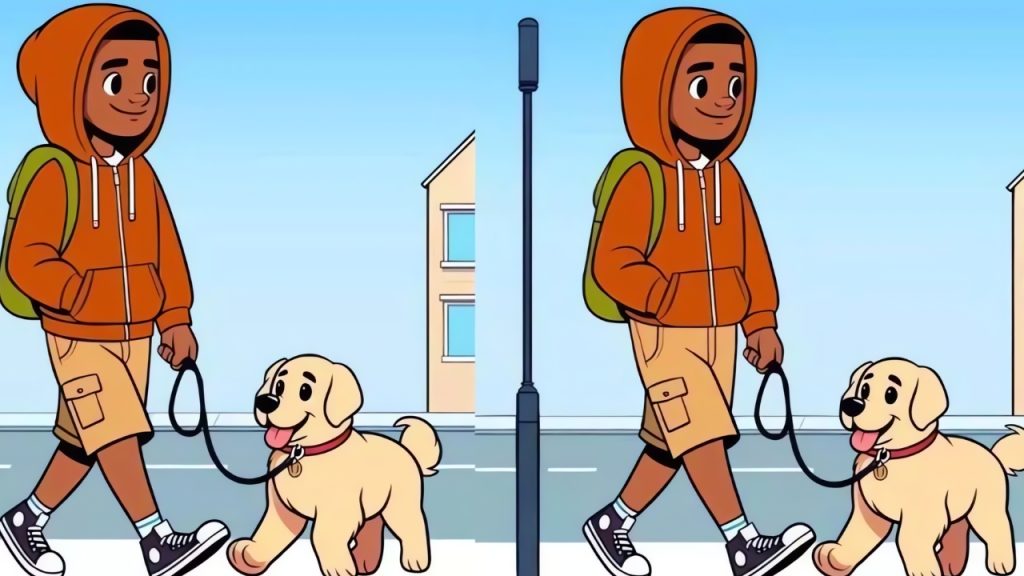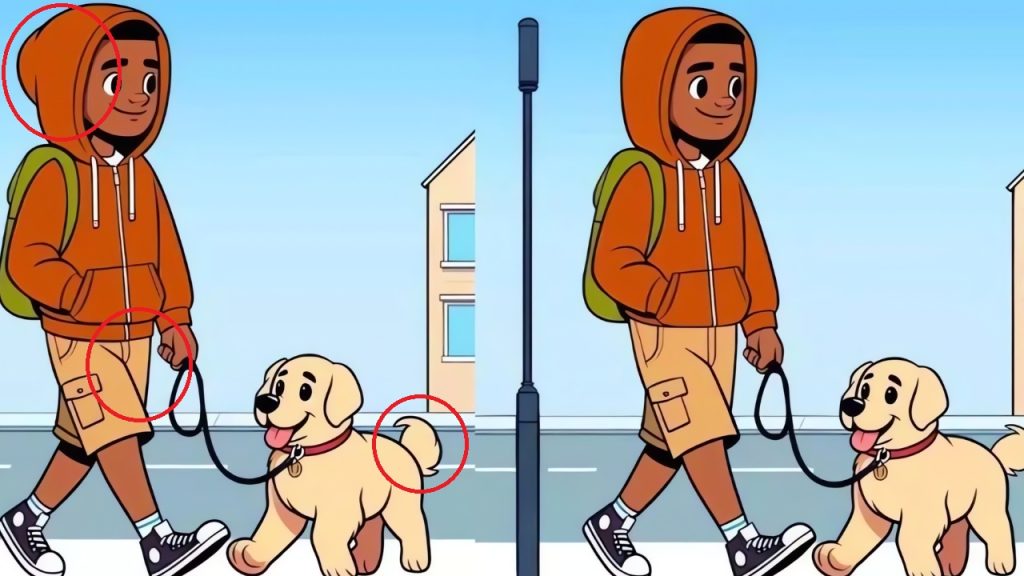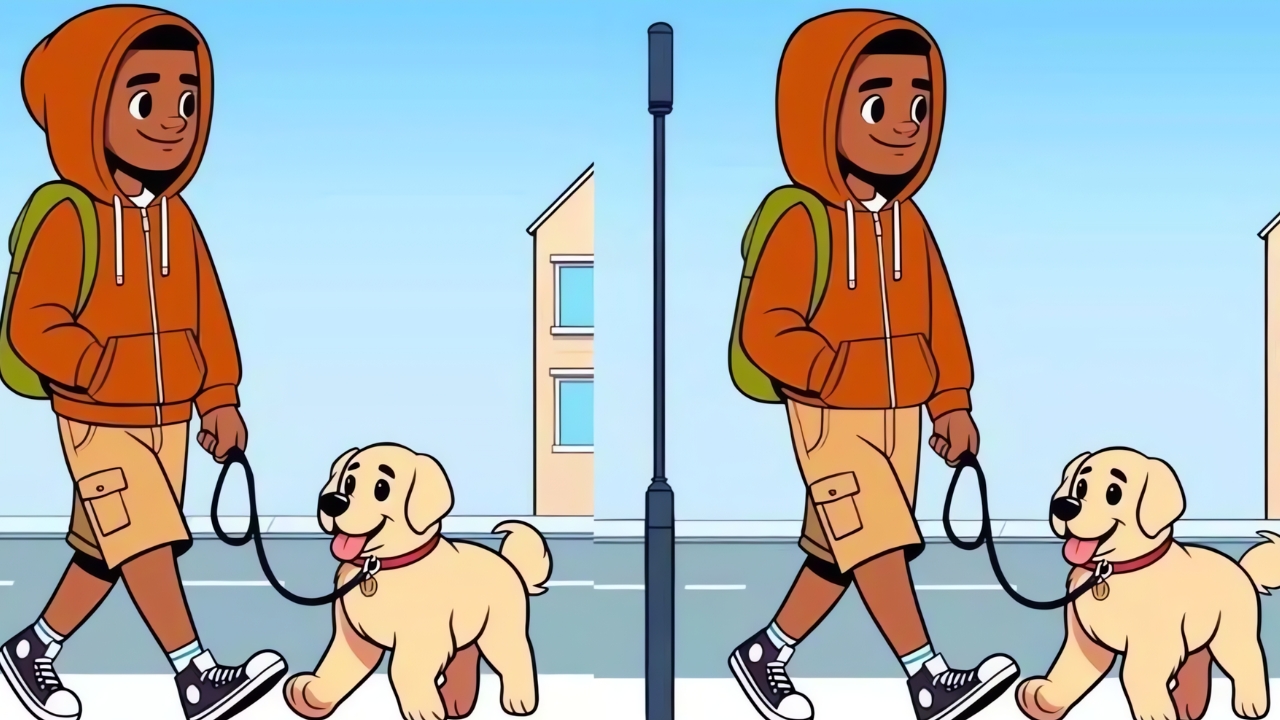Optical Illusion Challenge : Have you ever wondered how sharp your eyes really are? Well, today’s your lucky day because we’re about to put those observation skills to the ultimate test!
There’s this incredible optical illusion making waves across social media platforms. People everywhere are scratching their heads, squinting at their screens, and calling their friends over for help.
What Makes This Optical Illusion So Special?
This isn’t just your ordinary spot-the-difference puzzle. What makes this challenge absolutely mind-boggling is the time constraint that comes with it.
You get exactly five seconds to find three hidden differences between two seemingly identical images. Sounds easy? Think again, my friend!

The image shows a cute scene of a child walking alongside their furry companion. At first glance, both pictures look completely identical, almost like perfect twins.
But here’s where things get interesting. Hidden within these innocent-looking images are three sneaky differences that most people completely miss.
Why Our Brains Love These Visual Puzzles
Our minds are fascinating machines, constantly processing thousands of pieces of information every single second. Sometimes though, they need a little workout to stay in tip-top shape.
Optical illusions serve as the perfect gym equipment for our brains. They force us to look beyond what we expect to see and focus on tiny details we might otherwise ignore.
The Science Behind Visual Processing
When we look at any image, our brain immediately starts making assumptions. It fills in gaps and creates patterns based on what it thinks should be there.
This amazing ability helps us navigate daily life efficiently. However, it can also work against us when solving tricky visual puzzles like this one.
Scientists have discovered that regular engagement with visual challenges can improve our cognitive flexibility. This means our brains become better at switching between different ways of thinking.
Pretty cool, right? Who knew that having fun with puzzles could actually make us smarter!
How Different People See Things Differently
Everyone’s brain processes visual information in its own unique way. Some folks are naturally better at spotting tiny details, while others excel at seeing the bigger picture.
Age can also play a role in how we tackle these challenges. Younger eyes might catch movement-related differences faster, while experienced eyes often notice subtle color variations.
Breaking Down the Child and Dog Challenge
Let’s dive deeper into this particular puzzle that’s got everyone talking. The scene depicts a heartwarming moment between a child and their four-legged friend.
Both images appear to show the exact same moment in time. The child seems to be in the same position, the dog looks identical, and even the background elements match perfectly.
The Three Hidden Differences Revealed
After countless people attempted this challenge, the creators finally revealed where those sneaky differences hide. Ready for the big reveal?
Difference number one lies in the lower portion of the child’s jacket. It’s such a subtle change that most people completely overlook it during their first few attempts.
The second difference involves the dog’s tail. Now, this one’s particularly tricky because our eyes naturally focus on the child first, often missing our furry friend’s details.
Difference number three can be found in the child’s jacket hood area. This change is so minimal that it requires incredible attention to detail to spot.
Why These Specific Changes Are So Effective
The puzzle creators were absolutely brilliant in their choice of differences. They didn’t go for obvious changes like completely different colors or missing objects.
Instead, they opted for subtle modifications that challenge our pattern recognition abilities. These tiny alterations force our brains to work harder and pay attention to details we’d normally ignore.
Proven Strategies for Spot-the-Difference Success
Feeling frustrated because you can’t crack this puzzle? Don’t worry! Even the sharpest eyes need some guidance sometimes.
Here are some battle-tested techniques that puzzle experts swear by for solving these visual challenges quickly and efficiently.
The Systematic Scanning Method
Instead of randomly looking around the image, try dividing it into sections. Start from the top-left corner and work your way across systematically.
This approach ensures you don’t miss any areas and prevents your eyes from jumping around aimlessly. Many puzzle champions use this exact technique during competitions.
Move your focus in a zigzag pattern across the image. Spend about one second in each section before moving to the next area.
Remember, you’re looking for things that seem “off” or slightly different from what your brain expects to see.
The Overlay Technique
If you’re viewing these images on a screen, try quickly switching your focus between the two pictures. Sometimes differences become more obvious when you see them in rapid succession.
This technique works because our brains are excellent at detecting movement and change. When you rapidly shift focus, differences often seem to “pop out” at you.
Focus on Common Difference Areas
Puzzle creators often hide differences in specific types of locations. Clothing details, facial features, background objects, and body positions are popular hiding spots.
Pay special attention to areas where objects meet or overlap. These boundary areas are prime real estate for sneaky modifications.
The Psychology Behind Time Pressure
Why do these puzzles become so much harder when there’s a time limit involved? The answer lies in how our brains respond to pressure.
When we know we’re racing against the clock, our stress levels increase slightly. This stress can actually help us focus more intensely, but it can also make us miss obvious details.
How Stress Affects Visual Perception
Under time pressure, our brains tend to take more shortcuts. We rely heavily on our expectations and past experiences to fill in details quickly.
This survival mechanism served our ancestors well when they needed to spot predators quickly. However, it can work against us when we’re trying to notice subtle puzzle differences.
Professional puzzle solvers often practice relaxation techniques to manage time pressure effectively. Deep breathing and staying calm actually improve performance significantly.
The Sweet Spot of Challenge Difficulty
Researchers have found that puzzles work best when they’re neither too easy nor impossibly hard. This particular 5-second challenge hits that sweet spot perfectly.
It’s challenging enough to engage our full attention but not so difficult that we give up immediately. This balance keeps us motivated and coming back for more.
Benefits of Regular Brain Training Through Visual Puzzles
Making optical illusions and spot-the-difference puzzles part of your routine can provide some amazing mental benefits. Let’s explore what science tells us about these advantages.
Enhanced attention to detail is probably the most obvious benefit. Regular puzzle solving trains your eyes to notice things others might miss completely.
Improved Memory and Concentration
Working on visual puzzles regularly can boost both your short-term and long-term memory abilities. Your brain gets better at holding multiple pieces of information simultaneously.
Concentration skills also see significant improvement. These puzzles require sustained focus, which strengthens your ability to maintain attention for longer periods.
Students who regularly engage with visual puzzles often report better performance in subjects requiring detailed observation. This includes subjects like art, science, and even mathematics.
Stress Relief and Mental Relaxation
Believe it or not, solving puzzles can be incredibly relaxing. The focused attention required helps quiet the constant chatter in our minds.
Many people find that puzzle-solving sessions provide a welcome break from daily worries and anxieties. It’s like meditation but with a fun, engaging twist.
Social Connection and Family Bonding
These challenges become even more enjoyable when shared with friends and family members. Working together to solve puzzles creates positive shared experiences.
Family puzzle time can become a wonderful tradition that brings generations together. Grandparents, parents, and children can all participate regardless of age differences.
Different Types of Optical Illusions Explained
Not all optical illusions are created equal. Understanding the different categories can help you appreciate the variety and complexity of these fascinating visual phenomena.
Motion illusions create the impression of movement in static images. These often use carefully designed patterns that trick our motion detection systems.
Color and Contrast Illusions
These illusions play with how we perceive colors and brightness levels. The same color can appear completely different depending on its surrounding colors.
Famous examples include the dress that some people see as blue and black while others see white and gold. These differences highlight how individual our visual perception really is.
Size and Distance Illusions
Our brains constantly make judgments about the size and distance of objects. Clever illusion designers can manipulate these judgments to create surprising effects.
The Ponzo illusion is a classic example where two identical lines appear to be different lengths due to their surrounding context.
Geometric and Shape Illusions
These illusions involve shapes that seem to bend, twist, or change before our very eyes. They demonstrate how our brains try to make sense of complex visual information.
Impossible objects like the Penrose triangle fall into this category. Our brains struggle to process these shapes because they can’t exist in three-dimensional reality.
Tips for Creating Your Own Spot-the-Difference Puzzles
Feeling inspired to create your own visual challenges? Here are some insider secrets that professional puzzle makers use to craft engaging differences.
Start with a detailed base image that has plenty of elements to work with. Busy scenes with multiple objects provide more opportunities for subtle modifications.
Choosing the Right Types of Differences
Color changes are popular but should be subtle. Shifting a blue object to navy blue works better than changing it to bright red.
Size modifications can be very effective when done carefully. Making a small object slightly smaller or larger often goes unnoticed initially.
Position changes involve moving objects slightly within the scene. A bird flying in a different spot or a cloud shifted a few pixels can create great challenges.
Testing Your Puzzle Difficulty
Before sharing your creation, test it with friends or family members. Time their attempts and note which differences they find first.
If everyone solves it immediately, make the differences more subtle. If nobody can find them, you might need to make them slightly more obvious.
Balance is key in creating puzzles that are challenging but not frustrating. The goal is to provide a satisfying “aha!” moment when differences are discovered.
The Cultural Impact of Viral Visual Challenges
Social media has transformed how we share and experience visual puzzles. Platforms like Facebook, Instagram, and TikTok have made these challenges accessible to millions worldwide.
Viral puzzle challenges often bring people together across cultural and language barriers. A good visual puzzle needs no translation and can be enjoyed by anyone.
How Algorithms Spread Visual Content
Social media algorithms love content that generates engagement. People naturally want to share puzzles with friends and family, creating organic viral spread.
Comment sections become lively discussion areas where people debate answers and share their solving strategies. This interaction further boosts the content’s reach.
The Business of Brain Teasers
The popularity of visual puzzles has created entire industries around brain training and cognitive improvement. Apps and websites dedicated to puzzles generate millions in revenue annually.
Educational institutions have also embraced visual puzzles as learning tools. Teachers use them to improve student attention and observation skills across various subjects.
Optical Illusion Answer

Frequently Asked Questions
Q: How long should I spend trying to solve a spot-the-difference puzzle? Don’t stress yourself out! Give it a genuine effort for a few minutes, then check the answers if needed.
Q: Are some people naturally better at these puzzles than others? Absolutely! Visual processing abilities vary between individuals, but everyone can improve with practice.
Q: Can solving puzzles really improve my brain function? Research suggests regular mental challenges can help maintain cognitive sharpness, especially as we age.
Q: What’s the secret to solving puzzles faster? Practice systematic scanning techniques and stay calm under time pressure for best results.
Q: Are optical illusions safe for children? Yes! These puzzles are excellent educational tools that can help kids develop observation and concentration skills.
Q: Why do some differences seem obvious after they’re pointed out? Our brains focus on patterns and expectations, often filtering out details that don’t match our mental models.
Q: How often should I practice with visual puzzles? Even a few minutes daily can provide benefits, but there’s no strict requirement – enjoy them at your own pace.
Q: Can these puzzles help with real-world observation skills? Many people report improved attention to detail in daily life after regular puzzle practice.
Q: What makes a good spot-the-difference puzzle? The best puzzles balance challenge with solvability, using subtle but fair differences that reward careful observation.
Q: Are digital puzzles as effective as printed ones? Both formats offer benefits, though some people prefer the tactile experience of working with physical puzzle books.
